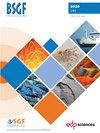Julius Kaljuvee, Ivan Reinwald, and Estonian pioneering ideas on meteorite impacts and cosmic neocatastrophism in the early 20th century
IF 2.6
3区 地球科学
Q2 GEOSCIENCES, MULTIDISCIPLINARY
引用次数: 1
Abstract
The article comprehensively presents little known Estonian contribution to the recognition of first meteorite impact structures in Europe, related to works of Julius Kaljuvee (Kalkun; 1869–1940) and Ivan Reinwald (Reinwaldt; 1878–1941). As an active educator specialized in geoscience, Kaljuvee was the first to hypothesize in 1922 that Kaali lake cirque in Saaremaa Island, Estonia, was created by meteorite impact. Thanks to mining engineer Reinwald, this assumption was accepted since 1928 due to the exhaustive field and borehole works of the latter (also as a result of exploration by several German scholars, including renowned Alfred Wegener). The impact origin of Kaali structure was proved finally in 1937 by finding of meteoritic iron splinters (as the first European site). Reinwald was not only outstanding investigator of meteorite cratering process, but also successful propagator of the Estonian discoveries in Anglophone mainstream science in 1930s. In addition, in his 1933 book, Kaljuvee first highlighted an impact explanation of enigmatic Ries structure in Bavaria, as well as probable magmatic activation in distant regions due to “the impulse of a giant meteorite”. He also outlined ideas of the inevitable periodic cosmic collisions in geological past (“rare event” theory nowadays), and resulting biotic crises. In a general conceptual context, the ideas of Kaljuvee were in noteworthy direct or indirect link with concepts of the great French naturalists – Laplace, Cuvier and Elie de Beaumont. However, some other Kaljuvee’s notions, albeit recurrent also later in geoscientific literature, are queer at the present time ( e.g. , the large-body impact as a driving force of continental drift and change the Earth axis, resulting in the Pleistocene glaciation). Thus, the Kaljuvee thought-provocative but premature dissertation is rather a record of distinguishing erudite activity, but not a real neocatastrophic landmark in geosciences history. Nevertheless, several concepts of Kaljuvee were revived as the key elements in the current geological paradigm.Julius Kaljuvee, Ivan Reinwald和爱沙尼亚人在20世纪早期提出了陨石撞击和宇宙新灾变论的先驱思想
这篇文章全面介绍了鲜为人知的爱沙尼亚对欧洲第一个陨石撞击结构识别的贡献,与朱利叶斯·卡尔朱维(Kalkun;1869-1940)和伊万·莱茵瓦尔德(莱茵瓦尔德;1878 - 1941)。作为一名活跃的地球科学教育家,Kaljuvee在1922年第一个提出假说,认为爱沙尼亚萨雷马岛的卡利湖马戏团是由陨石撞击造成的。由于采矿工程师Reinwald,这一假设自1928年以来被接受,这是由于后者的详尽的实地和钻孔工作(也是几位德国学者的探索结果,包括著名的Alfred Wegener)。1937年,在陨铁碎片的发现(作为欧洲的第一个地点)最终证明了卡利构造的撞击起源。赖因瓦尔德不仅是杰出的陨石形成过程研究者,而且是20世纪30年代英语国家主流科学中爱沙尼亚发现的成功传播者。此外,在他1933年的著作中,Kaljuvee首先强调了对巴伐利亚神秘的里斯结构的撞击解释,以及由于“巨大陨石的冲击”而在遥远地区可能发生的岩浆激活。他还概述了地质历史上不可避免的周期性宇宙碰撞(现在的“罕见事件”理论)以及由此产生的生物危机的观点。在一般的概念背景下,卡尔朱维的思想与伟大的法国博物学家——拉普拉斯、居维叶和埃利·德·博蒙特的概念有着值得注意的直接或间接联系。然而,Kaljuvee的其他一些观点,尽管在后来的地球科学文献中也反复出现,但在现在看来是奇怪的(例如,大天体撞击是大陆漂移的驱动力,改变了地轴,导致更新世冰川作用)。因此,卡尔朱维的这篇发人深省但不成熟的论文,与其说是一篇杰出的学术活动记录,不如说是地球科学史上真正的新灾难里程碑。尽管如此,卡尔朱维的几个概念作为当前地质范式的关键要素重新出现。
本文章由计算机程序翻译,如有差异,请以英文原文为准。
求助全文
约1分钟内获得全文
求助全文
来源期刊
CiteScore
5.80
自引率
0.00%
发文量
18
审稿时长
>12 weeks
期刊介绍:
BSGF - Earth Sciences Bulletin publie plusieurs types de contributions :
1. des articles originaux, couvrant tous les champs disciplinaires des Géosciences, à vocation fondamentale mais également à vocation plus appliquée (risques, ressources);
2. des articles de synthèse, faisant le point sur les avancées dans un domaine spécifique des Géosciences, qu''elles soient méthodologiques ou régionales ;
3. des monographies sur la géologie d’une région donnée, assorties d’informations supplémentaires, cartes, coupes, logs, profils sismiques … publiées en ligne en annexe de l’article ;
4. des articles courts de type « express letter » ;
5. des livrets-guides d’excursion (qui suivront le même processus d’examen éditorial que les articles plus classiques) ;
6. des comptes rendus de campagnes à la mer ;
7. des articles de données géodésiques, géophysiques ou géochimiques, pouvant devenir des articles de référence pouvant conduire à des interprétations ultérieures.
BSGF - Earth Sciences Bulletin constitue également un forum pour les discussions entre spécialistes des Sciences de la Terre, de type comment-reply ou autre. Tous les articles publiés, quelle que soit leur forme, seront accessibles sans frais (articles en Open Access) sur le site de la SGF et sur celui de Geosciences World dans la mesure où les auteurs se seront acquittés d’une contribution de (Article Processing Charges – APC) de 300€ pour les membres de la SGF et 500€ pour les non-membres.

 求助内容:
求助内容: 应助结果提醒方式:
应助结果提醒方式:


